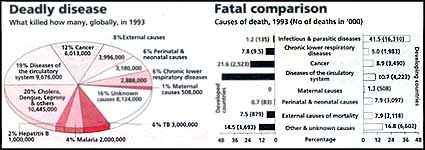Bodies of evidence
 IT IS a profoundly unhealthy world we occupy today. THE World Health Report, 1995 brought out by the World Health Organization, Geneva, reveals that about 51 million people died in 1993 worldwide: about 39 million in the developing world, about 12 million in the developed. Infectious and parasitic diseases were the biggest exterminators. The largest cause of death were heart attacks and strokes.
IT IS a profoundly unhealthy world we occupy today. THE World Health Report, 1995 brought out by the World Health Organization, Geneva, reveals that about 51 million people died in 1993 worldwide: about 39 million in the developing world, about 12 million in the developed. Infectious and parasitic diseases were the biggest exterminators. The largest cause of death were heart attacks and strokes.
Communicable diseases such as tuberculosis accounted for 20 million; noncommunicable diseases such as cancer totalled about 19 million. One in 2 deaths in the developing world is due to that symptom of abject poverty: communicable diseases. In the fat cat developed world, 3 out of 4 deaths are due to noncommunicable diseases, many of them lifestyle related.
Related Content
- Joint committee report on pollution of Chandlai lake, Jaipur, Rajasthan, 21/11/2024
- Bio-energy and waste to energy: recovery of energy from urban, industrial and agricultural wastes/residues and role of urban local bodies in energy management
- The climate change and conflict nexus in West Africa: a new approach for operationally relevant vulnerability assessments
- Order of the National Green Tribunal regarding conversion of water body into land and construction made thereon, Howrah, West Bengal, 07/01/2021
- Advancing gender equality through agricultural and environmental research: past, present, and future
- Reforms in urban planning capacity in India
